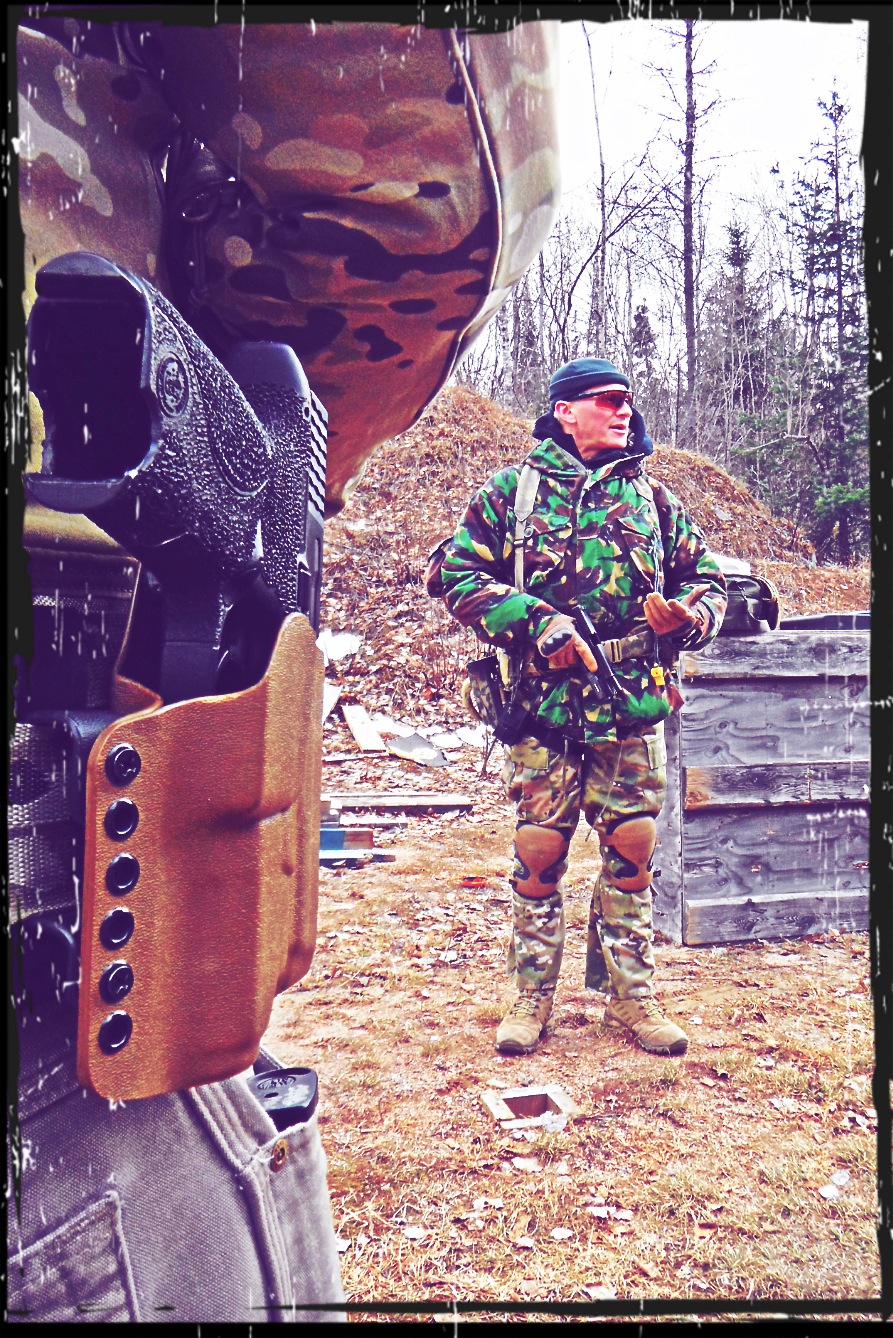PLGT Low Light Course was conducted at the Rock Cut Range, outside Powassan, Ontario Canada on 20-21 April 2013. The Primary Training Audience (PTA) for this course is the proficient shooter with the need to operate tactically in adverse lighting conditions. While concentrating on consistency of platform and proven tactics, techniques and procedure (TTPs), the course covered daylight and low-light firearms operation, dry-fire and live fire drills. Earl Green, the owner and chief instructor for Phase Line Green Tactical, has over 18 years of instructing tactical operators for multiple police forces and private teams. He draws on his experience in provincial policing and nuclear security teams which included “uniform patrol, uniform supervision, use of force and firearms training, tactical training, tactical operations, specialized training development and delivery, executive protection and criminal investigations.”
 |
| Earl Green covering the fundamentals of pistol operation |
During PLGT Low Light Course, the Primary Training Audience
(PTA) was a healthy split between veteran tactical operators from various
branches of the Canadian Armed Forces and skilled civilian shooters looking to
add to their toolbox. The combat experienced soldiers were able to enhance the
instruction by relating operational encounters to reinforce pertinent lessons.
Recognizing the depth of experience, Earl Green used an experienced medic to
give an informal brief on range GSW kits during a break. There was no division
between professionals and civilians; just shared learning.
 |
| While a student zeroes his rifle, an informal brief on GSW kits was given by an experienced military medic. |
The first day of training concentrated on TTPs on the employment
of pistols in adverse lighting conditions and low light. PLGT training
principles promote the fundamentals of consistent pistol operation, regardless
of light or low-light environment. Earl Green, self admittedly from his
background as a patrol officer and executive protection, believes that
proficiency with handgun is vital. The day started with a safety brief and a
review of the Big Four. The dry and live range practices during daylight hours
concentrated on perfecting a platform to deliver accurate hits. As light faded,
live fire drills included the use of handheld lights and weapon mounted lights.
PLGT recommends a dedicated weapon light on a sidearm but teaches multiple hand
held techniques as this will give you more options to react to the changing
tactical situation. Beside batteries die and technology fails.
 |
| Demonstrating the fundamentals of grips, sights and trigger control. |
The second day incorporates carbine and pistol used together in
low-light conditions. The day began with a quick review of the Big Four. As
there were multiple weapons systems in use and varied experience levels, a
review of carbine fundamentals and weapons transitions was covered. Again, PLGT
training principles promote the fundamentals of consistent carbine/pistol
operation, regardless of light or low-light environment.This clarification was
invaluable as the light faded and shot groups would open up as the level of
difficulty and distance increased. Multiple techniques and drills were covered with attention
on shot placement and effects of range, ambient light and illumination on
accurate interdiction. Earl Green demonstrated the incredible flash created by
a shotgun, with both slug and buckshot. This solidified the shotguns limited
effectiveness in night fighting. The course ended with the students and staff
identifying their carbine’s muzzle device and firing them individually in total
darkness for all other to observe. This was an excellent finish as it
demonstrated the effectiveness or ineffectiveness of available flash suppressors,
muzzle breaks or compensators.
 |
| One possible method of transitioning from primary to secondary with no sling mounted on carbine. |
Overall, this course was well organized and conducted. The
Rock Cut Range is an excellent range facility that supports IDPA and Three Gun
Matches as traditional hunting sports. The instruction was excellent. Earl Green is a
knowledgeable, experienced instructor who can use humour and corrective
techniques appropriately. Drawing on his operational experience and the
experience of others, he has distilled a realistic, relevant curriculum that
embraces fundamentals but adapts to the modern operational climate.
.JPG) |
| Daylight Pistol Warmup at 3-5-7 meters. |
IMPROVE:
There were some issues with students and reloaded
ammunition. This created some lulls from complex stoppages. Consider using
quality factory ammunition on a course.
Student zeroing their long guns on course created lulls in
training. This time was used for additional theory and an informal brief on GSW
kits. Take the time before a course to properly zero your long guns or arrive
early and confirm your zero before the course.
Some weapon lights went down due to batteries. Students
missed out on a bit of live fire drills as they changed batteries. Put fresh
batteries in your lights, sights and ancillary equipment for any course.
.jpeg) |
| FBI and Neck Index technique at 3-5-7 meters |
SUSTAIN:
Know your limits. One student during the team drills felt
that his skill level would not allow him to participate safely. He approached
the instructor and withdrew himself from that evolution and returned when he
felt comfortable. Bravo Zulu!
Two is one. One is none. When some students had equipment go
down, replacements were found within the course and loaned for them to continue
training. This exhibition of coursemanship and superior preparation was not
lost on junior students.
Leave your Ego at the door. There was a large amount of
operational experience on the range. The spirit of the course was one of
learning and sharing. Thank you to my fellow students for the experience and
camaraderie.
Take care out there.

No comments:
Post a Comment